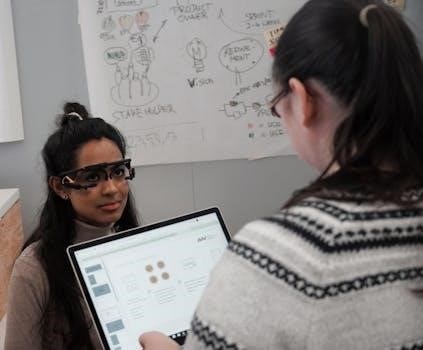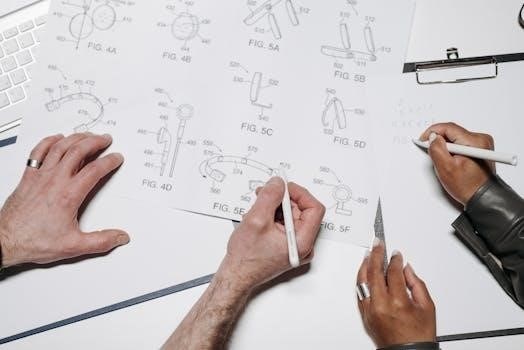Figma is a powerful design and prototyping tool‚ enabling designers to create interactive prototypes for web and mobile interfaces. It facilitates seamless collaboration‚ making it ideal for teams to bring creative ideas to life. Figma is a valuable asset for streamlining design workflows.
Figma’s Role in Design and Prototyping
Figma serves as a central hub in the design process‚ allowing for the creation of both visual designs and interactive prototypes. Its versatile features empower designers to transform static layouts into dynamic experiences. By enabling the development of interactive models‚ Figma plays a critical role in testing and refining user interfaces. This iterative process allows designers to validate their ideas‚ identify potential issues early on‚ and ensure that the final product aligns with user needs and expectations. Figma’s prototyping capabilities contribute to a more efficient and effective design workflow.
Setting Up and Navigating Figma
Getting started with Figma involves setting up an account and familiarizing yourself with its interface. Understanding the basic tools and layout is crucial for effective design work and prototyping;
Basic Tools and Interface Overview
Figma’s interface is intuitive‚ featuring a canvas‚ layers panel‚ and properties sidebar. Essential tools include the shape tools for drawing‚ the pen tool for custom paths‚ and text tools for adding content. The layers panel helps manage elements‚ while the properties sidebar allows for precise adjustments. Understanding these basic components is key to efficiently creating designs. You’ll learn to use tools to create shapes‚ manage layers‚ and navigate the workspace‚ making the design process more efficient and effective. It’s important to master these fundamentals to fully utilize Figma’s capabilities.
Prototyping Fundamentals in Figma
Prototyping in Figma involves creating interactive models to represent a product. These prototypes enable testing‚ validating concepts‚ and refining ideas‚ ensuring the final product meets user needs and expectations.
Creating Interactive Prototypes
Figma simplifies creating interactive prototypes using transitions without third-party apps. It allows designers to connect frames‚ enabling users to navigate through designs. You can define flow starting points through the right sidebar or by right-clicking on a frame. Figma’s prototyping tools make it easy to build and share high-fidelity‚ no-code‚ interactive prototypes‚ which is essential for testing user flows and interactions. These prototypes act as functional representations of the final design‚ ensuring a smooth user experience. This process helps designers refine ideas and identify problems early on.

Advanced Prototyping Features
Figma offers advanced features like Auto Layout for responsive design‚ allowing designs to adapt automatically to different screen sizes. These tools enhance efficiency and enable batch editing of multiple frames.
Auto Layout and Responsive Design
Auto Layout in Figma is a crucial feature for creating responsive designs. It enables elements to adjust automatically based on their content and the size of the frame‚ eliminating manual resizing. This ensures that designs adapt smoothly across various devices. Furthermore‚ constraints and auto layout settings are fundamental for effective responsive behavior. Designers can save time and effort by batch editing multiple frames simultaneously‚ whether in a system or freeform layout‚ thus streamlining the design process for different screen sizes and ensuring consistency.
Collaboration and Sharing
Figma excels in team collaboration‚ allowing multiple users to work on the same design file simultaneously. Its sharing options streamline workflows‚ making it perfect for remote teams to work together efficiently.
Team Collaboration in Figma
Figma’s real-time collaboration features allow multiple team members to work on the same design file simultaneously‚ fostering a dynamic and efficient workflow. This collaborative environment enables designers to share feedback‚ iterate on designs‚ and maintain a cohesive vision. Figma also offers seamless sharing options‚ making it easy to gather input from stakeholders. The platform facilitates clear communication and version control‚ ensuring everyone stays aligned throughout the design process. Its collaborative capabilities make it ideal for remote teams and projects that require collective input.

Prototyping for Different Devices
Figma allows setting device-specific prototype settings‚ like Pixel 2 or iPad Pro‚ ensuring designs adapt correctly. For multiple devices‚ use multiple pages in Figma for optimal results.
Device Specific Prototype Settings
In Figma‚ you can configure prototype settings to match specific devices like an iPhone‚ iPad‚ or Android phone. This ensures your prototype appears correctly on the chosen device screen‚ with appropriate scaling and layout. You can choose from preset device sizes or input custom dimensions for a more personalized experience. It is important for responsive design to consider these device settings to ensure a smooth user experience. Properly set device settings are essential for accurate testing and feedback‚ which are vital during the prototyping stage of the design process.
Figma’s Interactive Components
Figma’s interactive components allow you to create reusable elements with built-in interactions; This simplifies the prototyping process‚ enabling dynamic and consistent design elements across your projects.
Utilizing Components in Prototypes
Within Figma‚ components are essential for creating efficient and consistent prototypes. By using components‚ designers can create reusable elements that can be updated across the entire project. This ensures that design changes are quickly reflected in all instances‚ saving time and maintaining a uniform visual language. Interactive components take this a step further‚ enabling the creation of elements that respond to user actions‚ such as button clicks or state changes. This feature is critical for simulating the actual user experience during prototyping‚ and it is one of the best ways to make your prototypes more realistic.

Figma’s AI Features for Prototyping
Figma is exploring AI tools in beta‚ potentially enhancing prototyping workflows. These features‚ while still in development‚ could offer new ways to automate and improve the design process.
Exploring AI Tools in Figma (Beta)
Figma’s foray into AI is currently in beta‚ offering users a glimpse into potential future capabilities. While details are still emerging‚ these tools aim to streamline design and prototyping workflows‚ possibly automating repetitive tasks or generating design suggestions. The AI features are free during the beta period‚ but usage limits may apply. As these tools evolve‚ they could significantly impact how designers interact with Figma‚ making the design process more efficient and innovative. It is important to note that pricing information will be provided upon general release.

Exporting and Sharing Prototypes
Figma offers various sharing options for prototypes‚ allowing for easy collaboration and feedback. Users can share links‚ embed prototypes‚ and integrate with other workflows‚ facilitating seamless communication and testing.
Sharing Options and Workflow Integration
Figma simplifies the sharing process with multiple options for distributing prototypes. Users can generate shareable links‚ embed prototypes directly into websites or presentations‚ and invite collaborators for real-time feedback. This flexibility allows for easy integration into existing design workflows. Figma’s collaborative nature also promotes efficient communication and iteration among team members. Furthermore‚ the platform’s seamless handoff capabilities streamline the transition from design to development‚ ensuring that prototypes can be easily implemented by developers. These integrated features greatly enhance productivity and ensure a smoother design process.
